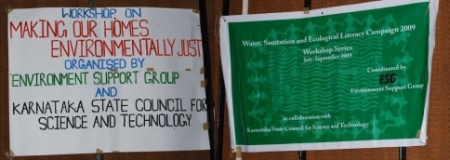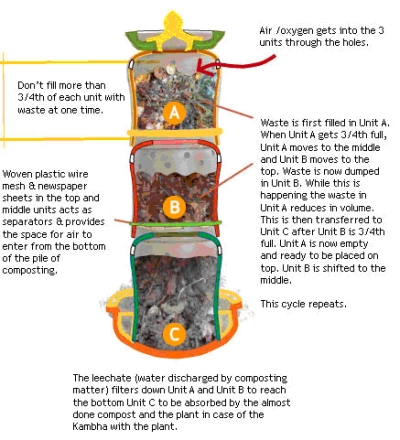How To Make Our Homes Environmentally Just: Workshop
Download pdf version of the Report here.
7th November 2009

With the advent of a new century, there has been a drastic change in lifestyle of people everywhere. Upto 1980’s people in Bangalore would mostly walk or cycle to reach places. They would have open space all around the house with plants and trees providing greenery. Most houses had huge windows to provide sufficient light and ventilation. Floorings made of red-oxide and clay tiles helped reduce pest inflection into houses, and as materials were of significantly low impact compared with mosaic and marble tiles. Needless to state, energy guzzling electronic gadgets were few and far between, with a radio sufficiently entertaining and a TV a luxury that would be shared with neighbours.

This predominantly simple living has now changed. Walking and cycling is passe and people use cars or two wheelers even to go a few hundred metres down the road. Houses are built based on real estate value and thus have little or open space. What little is left is hogged by a concretised car parking area. Most houses have slippery marble flooring and people live with doors and windows closed; fans and Air Conditioners running full blast.
This change in lifestyle is one of the key reasons for global warming and consequent climate change, buzzwords one keeps hearing across the city, the country and the world.
In a tropical country like India which receives abundant sunlight throughout the year, we could utilise this big ball of sun as a source of energy. Educating and encouraging people to utilise free and abundant natural resources like the sun, rain and wind, while being careful with resources that are extractive and cause imbalances in our ecosystem, is a simple choice anyone can make to live lightly on this planet. It was this simple sentiment that brought close to a hundred people together in a workshop entitled “How to make our homes environmentally just” organised by Environment Support Group in collaboration with Karnataka State Council for Science and Technology on 7th November 2009 at Regional Institute of Co-operative Management, Padmanabhanagar, Bangalore.

The workshop started with Ms, Bhargavi Rao, Coordinator (Education) of ESG welcoming the participants. This was followed by introductory remarks by Mr. Leo F. Saldanha, Coordinator of ESG. Leo set the mood for the workshop by highlighting how our local choices to make build and make our homes as far as possible minimally extractive of natural resources, could actually help save forests from submergence for hydel dams, minimise the need for mining minerals and thus help save farming and forest dwelling communities from unnecessary and unjust displacement. This consciously just way of living could well be our successful pathway to minimise global environmental impacts, and could possibly help reverse global warming and climate change. He suggested that maximising use of natural energy sources, reducing consumption of natural resources, especially fossil fuel and reuse of available resources is the only way forward out of the planetary crises.
Sustainable Living
The first speaker for the day was Mr. Chockalingam, whose house is not connected to a grid for supply of electricity. He strongly believes getting power supply from a centralised grid is inefficient and wasteful of nature, besides causing unimaginable adverse consequences to villagers who lose homes so city dwellers live in comfort. Most are unawares of the origin of the electricity supply and thus aren’t troubled enough to worry about the ethical issues of production and supply of electricity.


Conscious of these contradictions in today’s urban living, Chokkalingam and his famly chose to build a house with mud blocks, primarily. In addition, a good component of the material use in the house was from recyclables, instead of buying new materials.
The house is planned with a courtyard in the center, thus aiding ventilation all around in the living area. This significantly excludes the need for fans, as the constant air circulation keeps the house cool and comfortable.
The house also has sky lights to get sufficient light during the day. Ceiling vents help in the evacuation of warm air which is replaced with cool air, thus producing a continuous current of fresh air. Trees help cut out the excess heat of the afternoon sun, especially from the west. The entire house is powered by solar panels – and use of every electrical appliance is commanded by the amount of energy stored.


Besides, the house has rain water harvesting with a tank capacity of approximately 10000 litres. Even storage of rain water is done in such a way that it minimises the need for lifting up water by pumping. For example, rain from one roof is filtered and collected over a toilet and serves its needs. Excess run off is let into the garden through submerged tanks. Further, recharge pits are made to raise levels of groundwater, and these are done with no investment of material, but by reusing old tyres!


A Green Home
Mr. Jaidip K. T. who spoke next explained how his family has been living without any external supply of water. The house occupies a very small portion of their 15000 sq.ft. site. Their main source of water is a shallow borewell, that is largely recharged by sub-soil water and not deep aquifers – which is ancient water really. To sustain this borewell, a series of recharge wells are sunk all around, and this has aided in keeping the borewell flush with water.
His house uses a variety of intelligent design and environmental friendly technologies that primarily help recycle every water used. Grey water recycling helps flush all toilets, and also supplies water to the garden. Besides rain water is harvested.


The mechanism to reuse grey water from the bathroom and kitchen involves a series of filters that run through different graded material and plants. The longer the process of such filtration, the better is the quality of the water received ultimately in the well. The water in the well is then pumped and used to water plants.


The water run-off from washing machines in their house goes to a sump, which transfers the water to the flush tanks. So the water discharged from the washing machine is reused for flushing toilets. In addition, this house is equipped with a composting (dry) toilet.
Rain Water Harvesting
Mr. Navneeth of KSCST presented how Bangalore’s growth has made heavy extraction of water, making it a scarce resource in the city. With Cauvery waters becoming undependable and expensive to supply, and groundwater becoming scarce, there is little choice but to harvest rain.
The idea behind rain water harvesting is “capturing rain water where it falls” which can supplement the available supply and can be used for different purposes. Depending on whether the roof structure is flat or sloping, different methods could be used to capture rain, which can then be filtered and stored for use as per requirement. This harvested rainwater can also be used to recharge groundwater by different methods.
He also mentioned of the different places where the rain water harvesting system has been set-up which includes both rural and urban areas, the abandoned swimming pool in Bangalore Mahanagara Palike (BMP) office and Vidhana Soudha. The rain water harvesting units are being used for years now. KSCST has also launched a huge programme to build water security for all government run public schools in rural areas, and have so far covered a world record number of 26000 schools.


Alternate Building materials
Mr. Vijay Narnapatti addressed this in which he highlighted that use of alternate building materials are not just environmental friendly but also have an aesthetic appeal to it. He spoke using the specific example of the house of Mr. Dasarathi which he built.
Vijay preferred the use of natural stone and mud blocks in building homes, instead of fired bricks. Use of bamboos in the roofs was also another possibility that he is exploring with success. He also said how simple things like having sky lights and proper cross ventilation can minimise use of electricity for fans and light. Vijay also showed how Pine wood that comes as a packing material can be innovatively used to replace the need for fresh timber.
Composting
Savitha and Anupama from Daily Dump spoke out the aerobic method of composting that could be done at home level. There are different kinds of compost pots that Daily Dump produces and selection could be done based on the household requirement.
They showed one unit called as the “Kambha.” How a Kambha can be used is shown in the picture below, the source of which is the daily dump official website.

This was followed by Ms. Sruthi Subbanna of Environment Support Group who explained that with Bricks and Bagasse, composting of kitchen waste is a breeze. For a comprehensive review of the Bricks, Bagasse and Composting, method please access the comic strip at www.esgindia.org. At ESG, the BBC method of composting is being used to compost kitchen wastes since more than two years now with no problem whatsoever.


Legal
The final session was handled by Mr. Sunil Dutt Yadav, who spoke of the different laws that mandate environmentally friendly houses.. He explained that law is a minimum requirement for social change, and that communities and families should not be constrained by the minimality of law. Instead, one should innovate and minimise environmental impacts both in construction of houses and in living of homes. Indeed, the Government has made rainwater harvesting mandatory in all houses, but that should help our society to progressively reduce the need for import of water and energy.


The workshop ended with Mr. Leo Saldanha showing slides of his house where in he has rain water harvesting system set-up, and a well ventilated home surrounded by greenery which reduces use of fans. He also mentioned how by doing a simple thing like painting your roof white you could reduce the amount of heat that gets transmitted into the house, in turn making the house cooler and avoiding fans altogether.


The workshop concluded with Ms. Bhargavi Rao thanking all the participants, ESG team, and KSCST for their support and encouragement in making the workshop such a success.
Workshop Coordinator: Bhargavi S. Rao
Workshop Report: Sruthi Subbanna
Workshop Pictures: Lakshmi Nilakantan

